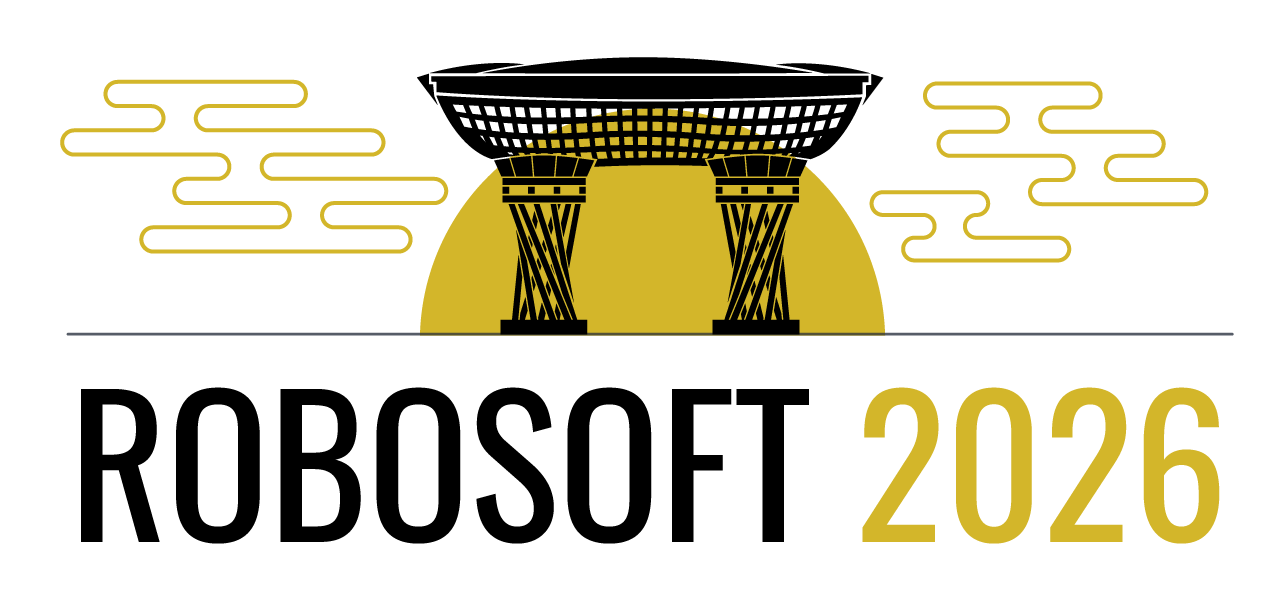Call for Papers
Overview and Deadlines
RoboSoft 2026 will be a high quality forum to interact across the boundaries of the different disciplines and range of topics, and it will be based on rigorously selected works bringing outstanding quality, originality and interest across disciplines.
The following types will be eligible for presentations:
- Contributed Papers (published in proceedings):
October 15th, 2025.
-> 8:00 AM on October 31th, 2025, (GMT, UTC-0)
11:59 PM on Oct. 30th, 2025. (PST)
(firm deadline. no extension!) - Extended Abstracts (not published in proceedings): February 15th, 2026.
-> Call for Extended Abstracts - Paper transfers from other IEEE Journals (already published)
- RA-L: transfer window TBA
- T-RO: transfer window TBA
- RAM: transfer window TBA
All times are in GMT (UTC-0); deadlines close at 4:00 p.m. on the stated date.
For both accepted contributed papers and transferred submissions, at least one author must present on site. If no author appears and the presentation is not given, the paper will not be included in the proceedings.
Submission
RoboSoft 2026 uses OpenReview as its submission system for conference papers. To be able to submit a paper, at least one author must be registered on OpenReview (ideally 7 days before the submission).
Please proceed here:
We will also be using double-anonymous peer review. This means that:
- The reviews will be made openly available on this platform post-review
- Submissions must be fully anonymized for double-anonymous review: remove author names, affiliations, acknowledgments, funding sources, self-identifying citations or links, and document metadata from the manuscript, figures, videos, and any supplementary materials.
Format
Contributed Papers
Manuscripts should be six pages (US letter size) in length, with a maximum of up to two extra pages that can be purchased. The number of pages includes the references, appendices, and acknowledgments. Papers should be formatted in standard IEEE format. Templates for LaTex and MS-Word are available at the RAS paper submission support page. Videos to complement the submission are strongly encouraged.
The presentation formats for accepted contributed papers are poster or oral presentation.
Videos should be submitted with your paper and have the following format:
- File size: 20MB
- File extension check and correction: mpeg, mp4, mpg
- Maximum duration: 3 minutes
- Minimum height: 480
- Minimum frame rate (fps): 20
- Scan type: progressive
Rules for Double-Blind Process
To make your paper submission anonomous, you should make best efforts to do so by following these rules.
- Do not include names and affiliations anywhere in the manuscript, appendix, supplementary material, and videos.
- Acknowledgments to people or funding agencies should be deleted.
- In self-citing authors’ previous work, avoid expressions such as “In our/the authors earlier work…”, rather use neutral expressions such as “In previous work…” or “In related work…”, in a manner that does not distinguish one’s own work from others.
- Remove any author/affiliation/lab names and logos from figures and videos.
- Blur faces from persons in videos and pictures.
- Robot identities should NOT be hidden, neither for unique robots. They are allowed to appear in pictures and videos. However, hide the individual name of the robots from the paper except if it is a widespread robot (eg Nao, Spots,…).
- Remove any author information from all submitted files’ metadata. This information is often added automatically from the identity information and can be found in “properties” under the “file” menu in word processors and PDF readers.
- There should be no links to external websites that reveal identity (e.g. YouTube, github, authors institute pages) or use tools to anonymize them like https://anonymous.4open.science/.
- Careless use of self-citations is always forbidden.
- Using tools as arXiv is allowed by authors, reviewers should not actively search for those articles to know identities.
Violations of those rules for material submitted for review can result in the paper being desk rejected. This information (except excess self-citations) can be added after the completion of the peer review process.

